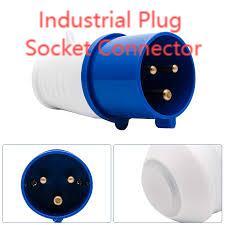Discusses modular connectors, spare-part strategies, and accessory compatibility that simplify upgrades and extend system longevity.

Ensuring uninterrupted power in industrial environments starts with choosing the right Industrial Plug Socket Connector for the application, and selecting the correct Industrial Plug Socket Connector early in project planning prevents compatibility problems, reduces downtime, and improves safety margins across the entire installation. Small components matter: contact geometry, plating, and housing design all influence how a connection behaves under load, vibration, and exposure to contaminants.
Design and build quality
A robust connector begins with solid mechanical design. Look for precision-molded housings that protect contacts from impact and ingress, plus reinforced strain-relief where cables enter. Contact carriers should resist creep and maintain alignment under vibration; thermally stable insulators prevent deformation at elevated temperatures. Metal shells or plated inserts improve mechanical strength where repeated mating cycles are expected. Quality at this level avoids intermittent faults that are costly to diagnose in busy industrial settings.
Electrical performance and ratings
Performance depends on rated current, voltage, and duty cycle. Low contact resistance reduces heating, while generous contact surface area and appropriate spring force ensure consistent conductivity. Materials and plating—often copper alloys with silver or nickel finishes—affect both conductivity and corrosion resistance. Match the connector’s rating to expected peak and continuous loads, and factor in derating where ambient temperatures are high or airflow is limited. Properly rated connectors also reduce the risk of thermal degradation and prolong service life.
Environmental protection and sealing
Many sites expose connectors to moisture, dust, and chemical sprays. IP-rated enclosures and gasketed mating faces prevent ingress, while engineered drainage paths avoid trapped condensation. Sealing systems should maintain performance over many cycles; look for gaskets resistant to compression set and housings that preserve lid compression under mechanical stress. For corrosive atmospheres, corrosion-resistant materials or protective coatings extend life and reduce maintenance intervals.
Installation practices and cabling strategy
Even the best connector can fail if installed incorrectly. Use correct-sized glands and maintain specified torque on terminals to prevent loose connections and overheating. Provide adequate bending radii and secure strain relief to prevent conductor movement from stressing terminations. Group power, control, and signal cables separately to minimize electromagnetic interference and simplify troubleshooting. Documenting cable IDs and torque values at handover helps future diagnostics and reduces human error during servicing.
Safety features and interlocks
Design elements that prevent misuse — such as keyed interfaces, locking mechanisms, and interlocks that require a circuit breaker to be open before unmating — add important layers of protection. Color coding, clear polarity marking, and tactile cues speed correct connection in low-light or noisy environments. Combining mechanical safeguards with clear labeling minimizes accidental disconnections and unsafe handling by non-specialist staff.
Maintenance, inspection, and lifecycle management
Scheduled inspections catch wear before failure. Check for contact discoloration, increased mating resistance, loose screws, and gasket compression loss. Thermographic scans under load reveal hotspots caused by poor connections. Keeping a record of mating cycles and environmental exposure helps predict replacement intervals. Stocking a small spare kit of common glands, gaskets, and contact modules shortens repair time and supports rapid return-to-service.
Compatibility, modularity, and upgrade paths
Choose connector families that support modular internals so contacts or seals can be replaced without changing the entire housing. This modularity reduces waste and lowers long-term costs. Compatibility with common accessory kits — mounting flanges, protective hoods, and locking collars — simplifies upgrades and allows the system to evolve as site requirements change.
Why supplier selection matters
A reliable supply chain and clear product documentation reduce specification risk. Suppliers that publish detailed datasheets, mating instructions, and torque charts make installation predictable. Manufacturers with after-sales support and available spares simplify maintenance planning. For teams specifying solutions, a trusted partner like Nante offers product ranges designed for industrial endurance and documented performance characteristics.
Conclusion and where to find models and specs
Choosing the right connector means matching electrical ratings, mechanical design, environmental protection, and serviceability to real-world conditions. Thorough site assessment, disciplined installation, and proactive maintenance preserve uptime and reduce life-cycle costs. For product models, mounting accessories, and technical details, visit www.nante.com/product/






